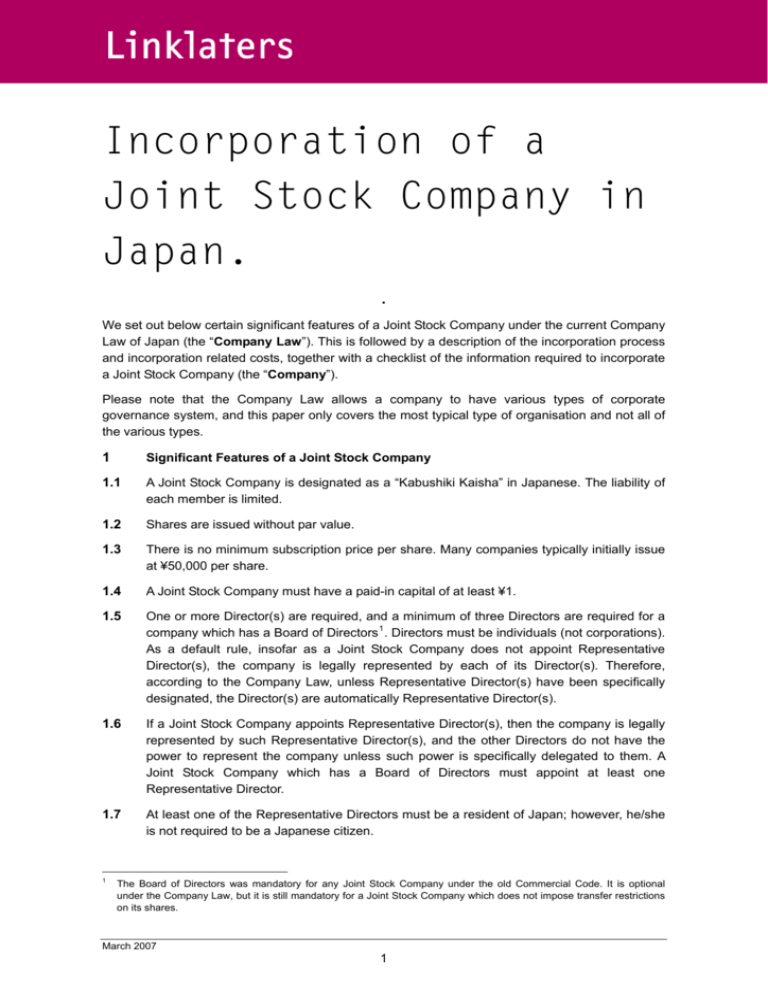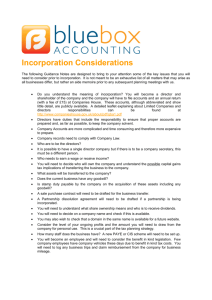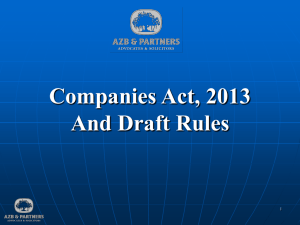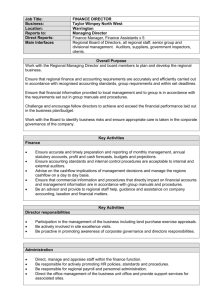
Incorporation of a
Joint Stock Company in
Japan.
.
We set out below certain significant features of a Joint Stock Company under the current Company
Law of Japan (the “Company Law”). This is followed by a description of the incorporation process
and incorporation related costs, together with a checklist of the information required to incorporate
a Joint Stock Company (the “Company”).
Please note that the Company Law allows a company to have various types of corporate
governance system, and this paper only covers the most typical type of organisation and not all of
the various types.
1
Significant Features of a Joint Stock Company
1.1
A Joint Stock Company is designated as a “Kabushiki Kaisha” in Japanese. The liability of
each member is limited.
1.2
Shares are issued without par value.
1.3
There is no minimum subscription price per share. Many companies typically initially issue
at ¥50,000 per share.
1.4
A Joint Stock Company must have a paid-in capital of at least ¥1.
1.5
One or more Director(s) are required, and a minimum of three Directors are required for a
company which has a Board of Directors 1 . Directors must be individuals (not corporations).
As a default rule, insofar as a Joint Stock Company does not appoint Representative
Director(s), the company is legally represented by each of its Director(s). Therefore,
according to the Company Law, unless Representative Director(s) have been specifically
designated, the Director(s) are automatically Representative Director(s).
1.6
If a Joint Stock Company appoints Representative Director(s), then the company is legally
represented by such Representative Director(s), and the other Directors do not have the
power to represent the company unless such power is specifically delegated to them. A
Joint Stock Company which has a Board of Directors must appoint at least one
Representative Director.
1.7
At least one of the Representative Directors must be a resident of Japan; however, he/she
is not required to be a Japanese citizen.
1
The Board of Directors was mandatory for any Joint Stock Company under the old Commercial Code. It is optional
under the Company Law, but it is still mandatory for a Joint Stock Company which does not impose transfer restrictions
on its shares.
March 2007
1
1.8
A Joint Stock Company may appoint one or more Statutory Auditor(s) 2 . A Joint Stock
Company which has a Board of Directors, requires at least one Statutory Auditor. Statutory
Auditor(s) must be individual(s) but they are not required to be Japanese citizens.
1.9
A Joint Stock Company capitalised at over ¥500 million and which imposes transfer
restrictions on its shares, requires at least one Statutory Auditor and at least one
Accounting Auditor.
1.10
A Joint Stock Company capitalised at over ¥500 million and which does not impose any
transfer restrictions on its shares, requires a Board of Statutory Auditors and at least one
Accounting Auditor. A Joint Stock Company which has a Board of Statutory Auditors must
have 3 or more Statutory Auditors, half of which must be “external” Statutory Auditors. 3
1.11
A Joint Stock Company is legally incorporated upon the completion of registration at the
Legal Affairs Bureau of the Ministry of Justice.
2
Incorporation process
A Joint Stock Company is formed by filing the Articles of Incorporation, the minutes of the
subscribers, the minutes of the Board of Directors and certain other supporting documents
with a registrar of the Legal Affairs Bureau of the Ministry of Justice.
2.1
Ordinary process
2.1.1
Search for company name conflicts and discussion with registrar regarding the
object or purpose of the Company.
2.1.2
Execution and notarisation of the Articles of Incorporation.
2.1.3
Request to the handling bank to open an account for receiving payment of
subscription money.
2.1.4
Payment of subscription money to the handling bank. The handling bank will then
issue a certificate of deposit for the subscription money.
2.1.5
Initial General Meeting of Subscriber(s).
2.1.6
Investigation by the Director(s) and Statutory Auditor(s) (if any) of the due
execution of share subscription and payment of subscription money.
2.1.7
Resolution by the Director(s) (if any).
2.1.8
Filing with the registrar.
2.1.9
Report on acquisition of stock to the Bank of Japan under the Foreign Exchange
and Foreign Trade Law.
2
This is different from the “Accounting Auditor” which is an external appointee to audit the accounts, familiar in other
countries. The “Big 4” global accounting firms, as well as many smaller local firms, perform this role in Japan.
3
An External Statutory Auditor is a Statutory Auditor who has never been a Director, Executive Officer or employee of the
Joint Stock Company or any of its subsidiaries.
March 2007
2
2.2
Additional process
2.2.1
In the case of certain types of business 4 , prior notice to the Bank of Japan is
required 30 days before payment of subscription money.
2.2.2
A registration statement needs to be filed with the Kanto Financial Bureau for any
Joint Stock Company expected to be capitalised at ¥100 million or more before the
commencement of subscription of shares.
3
Incorporation costs
3.1
Notarisation
Notarisation of the Articles of Incorporation:
Revenue Stamp
¥40,000
Fee for the notary public
¥50,000
Total
¥90,000
Certified copies of the Articles of Incorporation (generally two to four copies are required):
approximately ¥2,000 per copy
3.2
Registration tax
0.7% of the total paid-in capital, with a minimum at ¥150,000
3.3
3.4
Others
3.3.1
Commissions for the handling bank: this will depend on the bank but is generally
not a significant expense
3.3.2
Certificates of commercial registration: ¥1,000
3.3.3
Certificate of registered seal impression for each Representative Director: ¥500 per
copy
3.3.4
Creation of the Representative Director’s seal: approximately ¥20,000
Post-incorporation matters
3.4.1
Intellectual property protection
3.4.2
Tax related filings
3.4.3
Immigration matters
3.4.4
Business licence
4
Checklist of information required for incorporation
4.1
Name of the Company in Japanese (The name of the Company must include the words
“Kabushiki kaisha” at the beginning or the end of the company name. Most foreign
companies have these words at the end. The Company may adopt an English designation
of the company name.)
4
These are sensitive industries such as telecoms, nuclear etc, but there are also some unusual industries such as
leatherworking.
March 2007
3
4.2
Object or purpose of the Company
4.3
Location of the Company’s head office (A specific address is required)
4.4
Shares
4.5
4.4.1
Will the transfer of the Company’s shares be subject to approval by the Board of
Directors (or approval of Representative Director, or resolution at the shareholders’
meeting)? (In the case of a wholly-owned subsidiary the answer is almost always
yes. In addition, a decision must be made as to which authority (e.g.
Representative Director, Board of Directors, Shareholders’ meeting) will give
approval to such a transfer).
4.4.2
Number of shares to be issued upon incorporation
4.4.3
Subscription price (Any amount may be chosen, although many companies initially
issue shares at ¥50,000 per share)
4.4.4
Total amount of paid-in capital (Paid-in capital is the subscription price per share
multiplied by the number of shares to be issued and must be no less than ¥1)
4.4.5
Authorised capital (Authorised capital is the maximum number of shares that may
be issued by the Company. In the case of a company that does not impose transfer
restrictions on its shares, the authorised capital must be no more than four times
the number of shares to be issued upon incorporation. In the case of a company
that does impose transfer restrictions on its shares, the authorised capital may be
any number equal to or greater than the number of shares to be issued upon
incorporation.)
Shareholder (parent company)
4.5.1
Name
4.5.2
Registered address
4.5.3
Person(s) authorised to represent
4.5.4
Nationality of the parent company
4.5.5
Main business of the parent company
4.5.6
Amount of paid-in capital
4.6
Fiscal year
4.7
Name and address of the Incorporator(s) (Is the initial Representative Director of the
Company willing to act as incorporator? An incorporator is a person who performs the
initial incorporation procedures. In a typical scenario, a Japanese resident will be
nominated as the incorporator who will, in addition to executing the incorporation
procedures, subscribe to one share of the company (the remaining shares will be
subscribed by the parent company). The one share subscribed by the incorporator will be
transferred to the parent company after incorporation. Note that the certificates of
registered seal impression or the signatures of all the incorporators are required for
notarisation of the Articles of Incorporation.)
4.8
Number of Director(s) (at least one) and Statutory Auditor(s) (if any) (Generally, no less
than three Directors and no less than one Statutory Auditor is required for a Joint Stock
March 2007
4
Company which has a Board of Directors. A specific number of Directors and Statutory
Auditors, or alternatively the maximum number of, Directors and Statutory Auditors may be
specified.)
4.9
Name of Director(s)
4.10
Name and address of Representative Director(s) (At least one Representative Director
must be an individual who is resident in Japan. If there is only one Director, then that
Director automatically becomes a Representative Director. Note that the certificate of the
registered seal or the signature of each of the Representative Directors will be required for
registration at the Legal Affairs Bureau.)
4.11
Name of Statutory Auditor(s) (if any)
4.12
Officers (if any)
4.12.1
Chairman
4.12.2
President
4.12.3
Vice President
4.12.4
Senior Managing Director
4.12.5
Managing Director
(These are titles that may be given to Directors. As a matter of practice, it is recommended
that a President is designated.)
4.13
Details of handling bank to receive payment of subscription money (The handling bank is
generally a Japanese bank or a foreign bank which has a branch in Japan and which has
an established relationship with the Company)
4.14
Will the Representative Director(s) have a seal? (The seal(s) will be registered as required
under Japanese law and will be used for binding the Company in various contexts)
4.15
Maximum aggregate annual remuneration to be paid to Directors by the Company and
maximum aggregate annual remuneration to be paid to Statutory Auditors by the Company
(if any) (The shareholders of the Company will be required to approve any remuneration
paid to the Directors and Statutory Auditors, which may be given as a specific number, a
range or an upper limit. In practice, many companies prefer to specify an upper limit.)
This publication is intended merely to highlight issues and not to be comprehensive, nor to provide legal advice. Should
you have any questions on issues reported here or on other areas of law, please contact one of your regular contacts at
Linklaters.
© Linklaters. All Rights reserved 2007
Please refer to www.linklaters.com/regulation for important information on the regulatory position of the firm.
We currently hold your contact details, which we use to send you newsletters such as this and for other marketing and
business communications.
We use your contact details for our own internal purposes only. This information is available to our offices worldwide and
to those of our associated firms.
If any of your details are incorrect or have recently changed, or if you no longer wish to receive this newsletter or other
marketing communications, please let us know by emailing us at marketing.database@linklaters.com
March 2007
5







